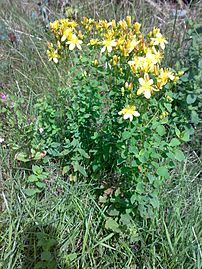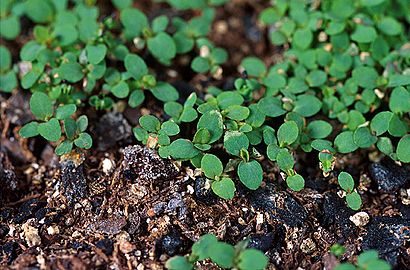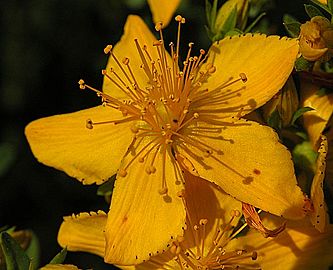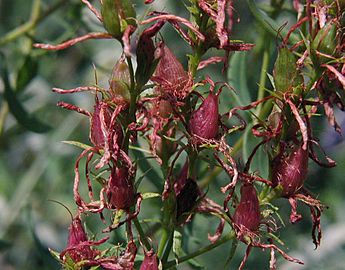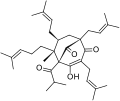St John's wort facts for kids
Quick facts for kids St John's wort |
|
|---|---|
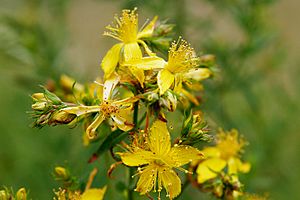 |
|
| Scientific classification | |
| Genus: |
Hypericum
|
| Species: |
perforatum
|
St. John's wort (its scientific name is Hypericum perforatum) is a pretty flowering plant. It belongs to the Hypericaceae family. This plant is special because it's the main example for its group, called Hypericum.
This plant might be a mix of two other plants, H. maculatum and H. attenuatum. You can find St. John's wort in many mild parts of Europe and Asia. It has also spread to North and South America, South Africa, and Australia, sometimes growing so much it becomes an invasive weed. Even though it can be bad for farm animals and can mess with prescription drugs, people have used it in folk medicine for hundreds of years. Today, it's still grown for these uses. Scientists are studying a chemical in it called Hyperforin to see if it has helpful properties.
Contents
What St. John's Wort Looks Like
St. John's wort is a plant that grows back every year. It has long roots that spread underground. Its reddish stems stand straight up and have branches near the top. They can grow up to 1 meter (about 3 feet) tall. The stems are a bit woody near the bottom.
The leaves grow in pairs on opposite sides of the stem and don't have stalks. They are long and narrow, about 1 to 2.5 centimeters (0.4 to 1 inch) long. The leaves are yellowish-green and have tiny, clear dots. If you hold a leaf up to the light, you can easily see these dots. This makes the leaves look like they have tiny holes, which is why it's called "perforated."
The flowers are bright yellow with small black dots. They are about 2.5 centimeters (1 inch) wide and have five petals and five sepals (leaf-like parts that protect the bud). Many flowers grow together in clusters at the ends of the upper branches. They usually bloom from late spring to mid-summer. Each flower has many stamens (the parts that make pollen). The seeds are black and shiny, with rough grooves.
If you crush the flower buds (not the open flowers) or the seed pods, they release a reddish or purple liquid.
Plant Chemicals
St. John's wort contains many natural chemicals. Some of the most important ones are hypericin, pseudohypericin, and hyperforin. These are the chemicals scientists believe might give the plant its effects. It also has other chemicals like flavonoids and essential oils.
How St. John's Wort Got Its Name
The scientific name perforatum comes from Latin. It means "perforated" or "with holes," which describes the look of the plant's leaves.
The common name "St. John's wort" can refer to any plant in the Hypericum group. So, to be clear, this specific plant is sometimes called "common St. John's wort" or "perforate St. John's wort."
The plant gets its name because it often flowers and is gathered around the summer solstice, which is near St. John's Feast Day on June 24. Long ago, people would hang the herb on doors to protect against bad spirits and sickness for people and animals.
The name Hypericum might come from ancient Greek words: hyper (meaning "above") and eikon (meaning "picture"). This could be because people used to hang these plants over religious icons in their homes on St. John's Day.
Where St. John's Wort Grows
St. John's wort originally comes from the mild parts of Europe and Asia. But it has spread all over the world to other mild areas. It was brought to North America from Europe.
This plant grows well in places that get rain in either winter or summer. However, it can't grow in very cold temperatures where seeds can't sprout. It also doesn't like very high altitudes (above 1500 meters or 4900 feet), very little rain (less than 500 mm or 20 inches), or very hot daily temperatures (above 24°C or 75°F).
You can often find St. John's wort in fields, pastures, and disturbed areas. It prefers sandy soils.
Plant Life and Reproduction
St. John's wort can make new plants in two ways:
- Vegetative reproduction: This means it can grow new plants from its roots or stems, without seeds.
- Sexual reproduction: This means it uses seeds.
The plant can change how it grows depending on the weather and how old it is. For example, if there's a lot of rain in the summer after insects or grazing animals have eaten its leaves, it will grow more new stems and leaves. Its seeds can stay alive in the soil for many years, waiting for a good time to sprout after the ground has been disturbed.
Plant Health and Diseases
St. John's wort can get diseases caused by tiny organisms called phytoplasmas. When infected, the plant changes its chemicals and shows signs like yellow leaves and unusual bushy growth. The levels of some important chemicals like hypericin go down, while others like chlorogenic acid go up. These diseases also reduce the amount of essential oil the plant produces.
Why It Can Be a Problem Plant
Even though St. John's wort is grown on farms in some parts of Europe, it's considered a harmful noxious weed in more than 20 countries. It has spread to North and South America, India, New Zealand, Australia, and South Africa.
In pastures, St. John's wort is a problem because it's both poisonous and invasive. It can take over areas where useful plants for animals usually grow. This can make farmland unusable. If farm animals like horses, sheep, or cattle eat too much of it, they can get sick. They might become sensitive to sunlight, get problems with their brain, or even die.
Farmers use special sprays (herbicides) to control St. John's wort. In western North America, some beetles like Chrysolina quadrigemina and C. hyperici have been brought in to help control the plant naturally.
Safety and Side Effects
In large amounts, St. John's wort is poisonous to animals that eat grass. Signs of poisoning include being restless and having skin irritation. Animals might scratch the ground, shake their heads, or rub their heads. They can also become confused or depressed. Sometimes, they might run in circles until they are tired. Animals usually try to find shade and don't want to eat much. They might also become very sensitive to water.
Severe skin irritation can cause redness on skin that isn't covered by hair or fur. This leads to itching, rubbing, swelling, and scabs. Sheep might have swollen faces and lose their wool from rubbing. Cows that are giving milk might produce less milk.
How to Tell if an Animal is Poisoned
Animals poisoned by St. John's wort often breathe and have a faster heart rate. One of the first signs is a higher body temperature. Affected animals will lose weight or not gain weight. Younger animals are usually more affected than older ones. In serious cases, animals can die from not eating enough, or from other sicknesses caused by the lesions. Some might even drown by accident.
Possible Side Effects for People
St. John's wort can cause allergic reactions in some people. It's very important to know that it can also interfere with many prescription drugs.
Generally, St. John's wort is tolerated well, but it can cause some side effects. These include stomach problems like nausea, belly pain, loss of appetite, and diarrhea. Other side effects can be dizziness, confusion, tiredness, feeling sleepy, dry mouth, restlessness, headaches, and high blood pressure.
St. John's wort can also lower the levels of estrogens (like estradiol) in the body by making the body break them down faster. Because of this, pregnant or breastfeeding women should not take St. John's wort.
Uses of St. John's Wort
Traditional Uses
People have used common St. John's wort in herbalism for hundreds of years. In ancient times, people believed it had healing powers. It was a common ingredient in old medicines. For example, a red, oily liquid made from St. John's wort was used to treat wounds, even by groups like the Knights Hospitaller. Today, St. John's wort is still grown and used in herbal and traditional medicine. Scientists are also studying if chemicals like hypericin and hyperforin have properties that could fight germs.
Modern Research
For Depression
Some studies suggest that St. John's wort might help with mild to moderate depression. A large review in 2015 found that it worked better than a fake pill (placebo) for depression. It also seemed to work as well as some regular antidepressant medicines, but with fewer side effects. In Germany, doctors sometimes prescribe St. John's wort for mild to moderate depression, especially for children and teenagers.
However, in the United States, St. John's wort is sold as a dietary supplement, not a medicine. This means it's not checked by the government in the same way as prescription drugs. The United States National Center for Complementary and Integrative Health says that St. John's wort seems to be effective for mild and moderate depression, but it's not clear if it helps with severe depression or if it works for longer than 12 weeks. They also advise that if someone has symptoms of depression, they should always talk to a doctor first.
Plant Chemicals and Supplements
Like other herbs, St. John's wort has different natural chemicals. When it's sold as a dietary supplement, there aren't always strict rules for how it's made. This means some products might not have the same amount of chemicals, or they could even have unwanted substances like metals or fillers.
Important Interactions with Medicines
Besides possibly causing allergies, St. John's wort can be very dangerous if taken with many prescription drugs. It can make these medicines less effective, which could be life-threatening.
For example, it can affect medicines used for:
- HIV
- Cancer (like irinotecan)
- Heart conditions (like digoxin and ranolazine)
- Medicines that prevent blood clots (like warfarin)
- Medicines that suppress the immune system (like cyclosporine)
Taking St. John's wort with some antidepressants can lead to too much serotonin in the body, which is a serious condition called serotonin syndrome.
People with certain health conditions like bipolar disorder, schizophrenia, or dementia should not take St. John's wort. It's also not recommended for people using other dietary supplements, headache medicines, or blood thinners.
St. John's wort can make the body break down certain medicines faster. This means the medicines don't stay in the body long enough to work properly. The chemicals hyperforin and amentoflavone in St. John's wort are thought to be responsible for these interactions.
Here are some examples of medicines that might not work as well if taken with St. John's wort:
| Type of Medicine | Examples |
|---|---|
| Medicines for HIV | Some non-nucleoside reverse transcriptase inhibitors, protease inhibitors |
| Medicines for anxiety | Alprazolam, midazolam |
| Medicines to stop the body from rejecting organs | Cyclosporine, tacrolimus |
| Heart rhythm medicines | Amiodarone, flecainide |
| Blood pressure medicines | Metoprolol, carvedilol |
| Calcium channel blockers | Verapamil, diltiazem |
| Cholesterol-lowering medicines | Lovastatin, simvastatin |
| Other medicines | Digoxin, methadone, warfarin, risperidone |
Images for kids
See also
 In Spanish: Hipérico para niños
In Spanish: Hipérico para niños


